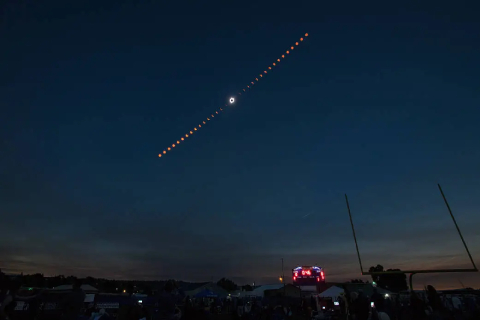By Matt Kelley (Radio Iowa)
It’s been seven years since a total solar eclipse darkened parts of the Midwest, and although Monday’s event won’t be a total eclipse in Iowa, it will be significant for most of the state. Chemistry and Planetary Sciences Professor Channon Visscher at Dordt University in Sioux Center, says you will definitely notice something’s happening.
“Up in the northwest corner of Iowa here, we’re gonna see about 75% coverage,” Visscher says. “If you go down to southeast Iowa, you’ll get up to about 90% of the sun’s just getting covered, but throughout most of the state we’re going to see about three-fourths of the sun get covered up by the moon.” The eclipse will begin about 12:40 pm, but Visscher says you won’t notice it until about 1 pm. The maximum coverage will occur around 2 pm, and the event will end about 3 pm. If the weather is clear, you will be able to view the partial eclipse, but Visscher says you’ll need eye protection.
“We recommend solar glasses, eclipse glasses, welding glass works, shade 14 or darker is typically what’s recommended,” he says. “Another popular technique is using a pinhole in a sheet of aluminum foil and you can cast an image of the sun, and you can see the little bite out projected on a surface.” The most spectacular part of an eclipse is the diamond ring effect when the moon completely covers the sun and just slightly moves off. Unfortunately, you must be in the area of totality to see that effect and the nearest point is southern Illinois and southeast Missouri. However, Visscher says a partial eclipse has its own unusual things to look for.
“The most noticeable thing during a partial is sort of the quality of the light shifts, the shadows shift,” he says. “In fact, we won’t have a lot of leaves on the trees yet but if you see sun passing through a tree for example, a lot of times what you can see is all sorts of little projections with little bits of the sun bit out by the moon.” Visscher says if you have a chance, get out and see it, as the next total eclipse in the vicinity won’t happen until 2045, and that will cover parts of Kansas and Colorado, not Iowa. If you plan to make the drive to be in the path of totality, Visscher says you want to be in the middle of the swath of totality for the longest view, about a 50- to 100-mile-wide area.
“Inside the path of totality, the total eclipse itself lasts about a maximum of about four minutes if you’re right near the center of it. It drops off to about two minutes near the edges,” Visscher says. “So that’s really a pretty brief moment in time, but that’s where you have that complete coverage of the moon in front of the sun.” Whether you travel to see the total eclipse, or stay put for the partial, remember to wear your solar eclipse glasses, which you can find at most retail outlets.




